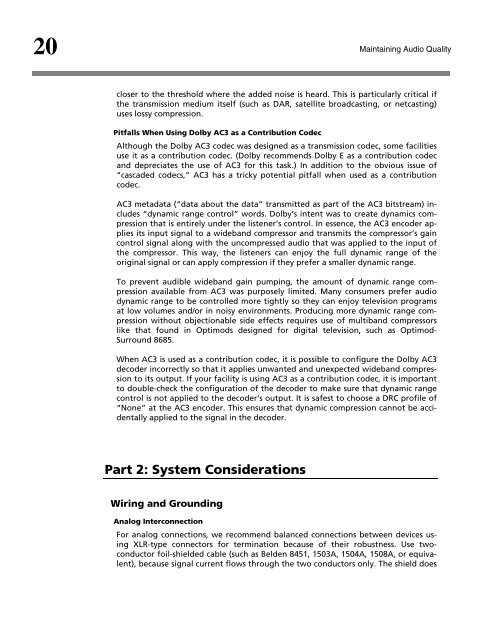Maintaining Audio Quality in the Broadcast Facility 2011 - Orban
Maintaining Audio Quality in the Broadcast Facility 2011 - Orban
Maintaining Audio Quality in the Broadcast Facility 2011 - Orban
You also want an ePaper? Increase the reach of your titles
YUMPU automatically turns print PDFs into web optimized ePapers that Google loves.
20<br />
<strong>Ma<strong>in</strong>ta<strong>in</strong><strong>in</strong>g</strong> <strong>Audio</strong> <strong>Quality</strong><br />
closer to <strong>the</strong> threshold where <strong>the</strong> added noise is heard. This is particularly critical if<br />
<strong>the</strong> transmission medium itself (such as DAR, satellite broadcast<strong>in</strong>g, or netcast<strong>in</strong>g)<br />
uses lossy compression.<br />
Pitfalls When Us<strong>in</strong>g Dolby AC3 as a Contribution Codec<br />
Although <strong>the</strong> Dolby AC3 codec was designed as a transmission codec, some facilities<br />
use it as a contribution codec. (Dolby recommends Dolby E as a contribution codec<br />
and depreciates <strong>the</strong> use of AC3 for this task.) In addition to <strong>the</strong> obvious issue of<br />
“cascaded codecs,” AC3 has a tricky potential pitfall when used as a contribution<br />
codec.<br />
AC3 metadata (“data about <strong>the</strong> data” transmitted as part of <strong>the</strong> AC3 bitstream) <strong>in</strong>cludes<br />
“dynamic range control” words. Dolby’s <strong>in</strong>tent was to create dynamics compression<br />
that is entirely under <strong>the</strong> listener’s control. In essence, <strong>the</strong> AC3 encoder applies<br />
its <strong>in</strong>put signal to a wideband compressor and transmits <strong>the</strong> compressor’s ga<strong>in</strong><br />
control signal along with <strong>the</strong> uncompressed audio that was applied to <strong>the</strong> <strong>in</strong>put of<br />
<strong>the</strong> compressor. This way, <strong>the</strong> listeners can enjoy <strong>the</strong> full dynamic range of <strong>the</strong><br />
orig<strong>in</strong>al signal or can apply compression if <strong>the</strong>y prefer a smaller dynamic range.<br />
To prevent audible wideband ga<strong>in</strong> pump<strong>in</strong>g, <strong>the</strong> amount of dynamic range compression<br />
available from AC3 was purposely limited. Many consumers prefer audio<br />
dynamic range to be controlled more tightly so <strong>the</strong>y can enjoy television programs<br />
at low volumes and/or <strong>in</strong> noisy environments. Produc<strong>in</strong>g more dynamic range compression<br />
without objectionable side effects requires use of multiband compressors<br />
like that found <strong>in</strong> Optimods designed for digital television, such as Optimod-<br />
Surround 8685.<br />
When AC3 is used as a contribution codec, it is possible to configure <strong>the</strong> Dolby AC3<br />
decoder <strong>in</strong>correctly so that it applies unwanted and unexpected wideband compression<br />
to its output. If your facility is us<strong>in</strong>g AC3 as a contribution codec, it is important<br />
to double-check <strong>the</strong> configuration of <strong>the</strong> decoder to make sure that dynamic range<br />
control is not applied to <strong>the</strong> decoder’s output. It is safest to choose a DRC profile of<br />
“None” at <strong>the</strong> AC3 encoder. This ensures that dynamic compression cannot be accidentally<br />
applied to <strong>the</strong> signal <strong>in</strong> <strong>the</strong> decoder.<br />
Part 2: System Considerations<br />
Wir<strong>in</strong>g and Ground<strong>in</strong>g<br />
Analog Interconnection<br />
For analog connections, we recommend balanced connections between devices us<strong>in</strong>g<br />
XLR-type connectors for term<strong>in</strong>ation because of <strong>the</strong>ir robustness. Use twoconductor<br />
foil-shielded cable (such as Belden 8451, 1503A, 1504A, 1508A, or equivalent),<br />
because signal current flows through <strong>the</strong> two conductors only. The shield does



![[PDF] Using the ITU BS.1770-2 and CBS Loudness Meters ... - Orban](https://img.yumpu.com/50629372/1/190x245/pdf-using-the-itu-bs1770-2-and-cbs-loudness-meters-orban.jpg?quality=85)






![[PDF] Optimod-FM Feature Comparison - Orban](https://img.yumpu.com/41741615/1/190x245/pdf-optimod-fm-feature-comparison-orban.jpg?quality=85)






